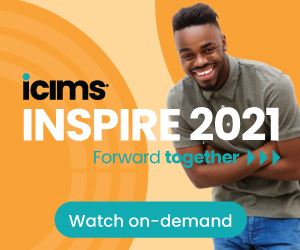- Solutions
- Products
- Community
- Resources
- Company
Create incredible candidate experiences that communicate your brand, mission, and values with recruitment marketing solutions.
Learn moreCommunicate effectively and efficiently with the candidates that can drive your business forward.
Learn moreSelect the right candidates to drive your business forward and simplify how you build winning, diverse teams.
Learn moreHelp your best internal talent connect to better opportunities and see new potential across your entire organisation.
Learn moreCommunicate collectively with large groups of candidates and effectively tackle surges in hiring capacity.
Learn moreAccess tools that help your team create a more inclusive culture and propel your DEI program forward.
Learn moreRebound and respond to the new normal of retail with hiring systems that are agile enough to help you forge ahead.
Learn moreAccelerate the hiring of key talent to deliver point of care and support services that meet and exceed your promise of patient satisfaction.
Learn moreAttract and engage candidates with technical competencies, accelerate hiring for much-needed skills, and advance expertise within your valued workforce.
Learn moreSimplify how you recruit finance, insurance, and banking candidates with a unified platform built to match top talent with hard-to-fill roles.
Learn moreYour business strategy depends on your people strategy. Keep both in lockstep with the iCIMS Talent Cloud.
Learn moreBuild an engaging, high-converting talent pipeline that moves your business forward.
Learn moreDeliver the innovation your talent team needs, along with the global scale and security you demand.
Learn moreDeliver tailored technology experiences that delight users and power your talent transformation with the iCIMS Talent Cloud.
Learn moreThe #1 ATS in market share, our cloud-based recruiting software is built for both commercial and large, global employers.
Learn more Talk to salesAttract the best talent for your business with powerful, on-brand career websites that excite candidates and drive engagement.
Learn more Talk to salesBuild talent pipelines, engage candidates with multi-channel marketing campaigns, and use machine learning to automatically surface the right talent for the job.
Learn more Talk to salesEmpower candidates with automated self-service, qualification screening, and interview scheduling through an AI-enabled digital assistant.
Learn more Talk to salesSimplify employee onboarding with automated processes that maximize engagement and accelerate productivity.
Learn more Talk to salesRecruit in the modern world and expand your reach with built-in virtual interviewing.
Learn more Talk to SalesFocus on qualifying candidates faster with fully integrated language assessments.
Learn more Talk to SalesImprove employee experience, retention, and reduce internal talent mobility friction with the iCIMS Opportunity Marketplace.
Learn more Talk to salesCompliment your sourcing and engagement efforts with sophisticated lead scoring and advanced campaign personalization.
Learn more Talk to salesModernize, streamline, and accelerate your communication with candidates and employees.
Learn more Talk to salesTransform the talent experience by showcasing your authentic employer brand through employee-generated video testimonials.
Learn more Talk to salesGive your business a competitive edge with a complete solution for creating personalized, timely, and accurate digital offer letters that inspire candidates to want to join your team.
Learn more Talk to SalesGet robust analytics that help you make sense of your data and illuminate your talent pool.
Learn moreSimplify recruiting, dynamically engage talent, and reduce hiring bias with job matching and recruiting chatbot technology.
Learn more Talk to salesThe #1 ATS in market share, our cloud-based recruiting software is built for both commercial and large, global employers.
Learn more Talk to salesAttract the best talent for your business with powerful, on-brand career websites that excite candidates and drive engagement.
Learn more Talk to salesBuild talent pipelines, engage candidates with multi-channel marketing campaigns, and use machine learning to automatically surface the right talent for the job.
Learn more Talk to salesEmpower candidates with automated self-service, qualification screening, and interview scheduling through an AI-enabled digital assistant.
Learn more Talk to salesSimplify employee onboarding with automated processes that maximize engagement and accelerate productivity.
Learn more Talk to salesCompliment your sourcing and engagement efforts with award-winning lead scoring and advanced campaign personalization.
Learn moreImprove employee experience, retention, and reduce internal talent mobility friction with the iCIMS Opportunity Marketplace.
Learn more Talk to salesModernise, streamline, and accelerate your communication with candidates and personnel.
Learn more Talk to salesTransform the talent experience by showcasing your authentic employer brand through employee-generated video testimonials.
Learn more Talk to salesGet robust analytics that help you make sense of your data and illuminate your talent pool.
Learn moreSimplify recruiting, dynamically engage talent, and reduce hiring bias with job matching and recruiting chatbot technology.
Learn more Talk to salesHow PRMG attracts 50% more applicants for niche finance roles with the iCIMS Talent Cloud.
Learn moreThousands strong, our global community of talent professionals includes creatives, innovators, visionaries, and experts.
Learn moreTogether we’re creating the world’s largest ecosystem of integrated recruiting technologies.
Learn moreExplore our network of more than 300 certified, trusted third-party service and advisory partners.
Learn moreExpert guidance about recruitment solutions, changes in the industry, and the future of talent.
Learn moreExpert guidance about recruitment solutions, changes in the industry, and the future of talent.
Learn moreStay up to date with the latest terminology and verbiage in the HR software ecosystem.
Learn morePartner with iCIMS to build the right strategies, processes, and experience to build a winning workforce.
Learn moreThe iCIMS Talent Cloud delivers a secure, agile, and compliant platform designed to empower talent teams, job seekers, and partners with advanced data protection and privacy.
Learn moreWatch the recording of our latest webinar looking at key findings from a recent study and explore short-term and long-term solutions for the talent crisis in 2022 and beyond.
Watch on-demandView press releases, media coverage, and the latest hiring data. See what analysts are saying about iCIMS.
Learn moreiCIMS is the Talent Cloud company that empowers organizations to attract, engage, hire, and advance the talent that builds a winning workforce.
Learn moreGet to know the award-winning leadership team shaping the future of the recruiting software industry.
Learn moreWe believe the future of work isn't something that "happens" to you. It's something you create. We actively create the future of work with our customers every day.
Learn moreStreamline your tech stack and take advantage of a better user experience and stronger data governance with ADP and the iCIMS Talent Cloud.
Learn moreThe combined power of iCIMS and Infor helps organizations strategically align their business and talent objectives.
Learn moreOur award-winning partnership with Microsoft is grounded in a shared desire to transform the workplace and the hiring team experience.
Learn moreOur partnership with Ultimate Kronos Group (UKG) supports the entire talent lifecycle by bringing frictionless recruiting solutions to UKG Pro Onboarding.
Learn moreLet’s get in touch. Reach out to learn more about iCIMS products and services.
Learn more
Artificial intelligence has permeated our lives in so many ways that we probably haven’t even noticed. A great example is a song called Not Easy, written with the help of IBM’s Watson AI, which recommended musical elements and lyrics based on a variety of different data inputs. For some people, it showcased the power of artificial intelligence. For others, it begged the question, “Will AI replace musicians? What if all music starts to sound the same?”
Talent acquisition professionals may share similar fears about AI recruiting software. “Will it take over my job?” “What risks does AI pose to initiatives like DEI?”
According to iCIMS Senior Product Marketing Manager Gazmend Kalicovic, these fears are largely unfounded. AI recruiting software has come a long way in many good ways. When implemented correctly, it has the potential to make life as a recruiter or TA professional a whole lot easier.
At INSPIRE 2021, Gazmend spoke with Andreea Wade, Senior Portfolio Director of AI/ML at iCIMS, and Job Simon, Technology Advisor, about how AI can be used to advance the best talent without removing that essential human element. To hear the full conversation, watch their session here.
Recruiters are not being replaced. Instead, the objective is to help professionals be more productive and make more informed decisions. Think of AI as “applied intelligence.” Its purpose is to enhance human capability, not replace it.
To better understand how AI supports talent acquisition today, let’s look at a few examples of automation.
These are just a few examples of how AI recruiting software can be used in talent acquisition. As you can see, these applications help streamline recruiter workflows, elevating the role of a recruiter to be less administrative and more proactive.
The bottom line: AI doesn’t replace human experience or instinct; it simply enhances it.
Another big concern around AI, specifically in talent acquisition, is related to bias. Is there any way to ensure that bias is completely removed from the hiring process?
The answer is not that simple. While we all want to avoid building products that create exclusionary experiences and discriminatory practices, it is possible to inadvertently introduce bias during the data preparation stage.
Data preparation involves selecting the attributes you want the algorithm to consider or ignore, like gender, education, years of experience, etc. Data selection is human-led which means bias can creep in despite best intentions.
To help remove bias from the hiring process, businesses that use AI should be intentional about how they select the data used to make predictions. This AI playbook from The Center for Equity, Gender and Leadership at the Haas School of Business (University of California, Berkeley) recommends asking questions like:
Additionally, it’s important to know that the model is an actively learning system. You can monitor the outcomes of your model to better understand how it is using your data to make predictions. Then, feed it back with the right set of information to improve its accuracy.
As Wade says in iCIMS whitepaper, 4 steps to strengthen responsible hiring with AI, “The whole world of fairness and bias starts with data.”
Many TA professionals wonder, “Can AI really be trusted?” The answer is yes, although you shouldn’t trust it without understanding the ethos behind the technology. Businesses can do several things to improve the trustworthiness of their AI recruiting software.
Here’s how iCIMS approaches this matter:
First, we have what we call our Ensemble AI. It’s our patent-pending approach that leverages three different engines, a multitude of algorithms, and a built-in polling system to make recommendations that reduce the likelihood of bias or error. As Wade says, “Three heads are always better than one.”
Second, iCIMS is constantly training and retraining our algorithms. We add new data points several times a year from multiple resources, geographic areas, and so on.
Third, we have a responsible AI program and a code of ethics that informs our bias detection and mitigation work. An international organization called AI Global, working together with the World Economic Forum, continually tracks and assesses major responsible AI initiatives. Through this work, they’ve created a unified framework called the responsible AI Trust Index. iCIMS’ code of ethics is aligned to this and its pillars.
AI recruiting software isn’t a replacement for human intelligence. TA decisions begin and end with humans, recommendations from artificial intelligence are meant to better inform those decisions.

and receive free tips on how to attract, engage, hire, & advance the best talent.




